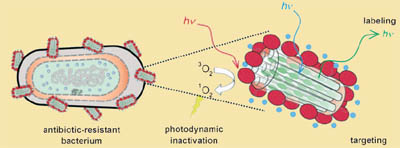
Posted on 09/09/2009 12:52:33 AM PDT by neverdem
German researchers have developed a hybrid, light activated nanomaterial that can target, label and kill harmful antibiotic resistant bacteria such as Escherichia coli. The zeolite-based material may one day play a major role in both diagnosing and treating infectious diseases and possibly cancer, suggests the team.
So-called 'photodynamic therapy' is a well-established technique in which a light source is used to trigger the action of a light-sensitive drug, and is already used to treat cancer and macular degeneration. However, scientists have been eager to develop cheaper therapeutic approaches with more functions. One such approach would be to develop a single nanomaterial that can carry out three important therapeutic jobs in one; that is, selectively target pathogens, label them (for diagnostic purposes) and then kill them.
Now, Cristian Strassert and colleagues at Westfälische Wilhelms-Universität Münster, Germany, have demonstrated that such a material can work in principle, offering exciting possibilities for next generation phototherapy. 'We have shown that it is possible to functionalise zeolite L in such way that we can label bacteria with a green fluorescence and kill them upon irradiation with red light despite their antibiotic resistance,' says Strassert.
Using zeolite L - a microporous molecular sieve - for the basic structure, the team made several modifications to make it tri-functional. In order to target living microorganisms, the team attached amino groups to the outer surface of the zeolite L nanocrystals. To label the cells, they inserted a highly green luminescent dye into the zeolite channels. And lastly, a photosensitiser that forms toxic singlet oxygen (1O2) when irradiated with harmless red light was added to the surface.

|
A multifunctional nanosized zeolite uses amino groups, a luminescent dye, and a1O2 producer to target, label, and kill pathogenic and antibiotic-resistant bacteria
© Angew. Chem. Int. Ed.
|
The team then tested the material using red light on separate suspensions of E. coli and Neisseria gonorrhoeae (the bacteria responsible for causing gonorrhoea). In both kinds of microorganism, around 95 per cent of cells were killed after two hours of irradiation. 'Besides the treatment and diagnosis of localised infectious diseases, we envisage the therapy of tumours and localised [growths] with red light,' adds Strassert.
'The work is extremely relevant and has an enormous potential in the nanomedicine field,' comments Manna Liberato, a nanochemistry expert at the Italian Institute of Technology, Genoa. 'The photodynamic activity of these nano-objects appears to be higher than that reported so far by other groups, since lower doses of light are required to inactivate the bacteria than those described in the literature,' he adds.
However, this work serves as a proof of principle study, and Strassert emphasises 'there is still a way to go' before the material can be applied. 'It is now necessary to prove the lack of toxicity, the broad applicability, and to enhance selectivity towards pathogens,' he says. 'In vitro and in vivo tests would be the next foreseeable steps.'
C S Strassert et al, Angew. Chem. Int. Ed., 2009, DOI: 10.1002/anie.200902837
Wonderful. They will need this for the bacterial slime that is nearly not removable from medical instruments like catheters, etc.
Disclaimer: Opinions posted on Free Republic are those of the individual posters and do not necessarily represent the opinion of Free Republic or its management. All materials posted herein are protected by copyright law and the exemption for fair use of copyrighted works.